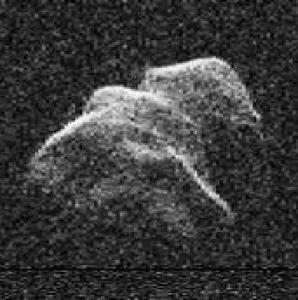The European Southern Observatory labeled yesterday the ‘Day of Toutatis,’ when the 4.6 kilometer-long asteroid passed Earth at no more than four times the Earth-Moon distance. Discovered in 1989, Toutatis swings close to Earth every four years, but not since 1353 has it come as close as yesterday. Closest approach occurred at roughly 1340 hours GMT (0940 ET). ESO’s coverage can be found here.
 Near-Earth asteroids like Toutatis are a reminder of the space debris that has showered Earth throughout its history. Our future in space is not optional: we’ll need the technology to detect and deflect any asteroids that seem likely to make impact (Toutatis does not), and that means building up a space-based infrastructure into the outer Solar System. It is exactly that kind of system-wide presence that will one day allow us to build and send our first interstellar probes.
Near-Earth asteroids like Toutatis are a reminder of the space debris that has showered Earth throughout its history. Our future in space is not optional: we’ll need the technology to detect and deflect any asteroids that seem likely to make impact (Toutatis does not), and that means building up a space-based infrastructure into the outer Solar System. It is exactly that kind of system-wide presence that will one day allow us to build and send our first interstellar probes.
You can read more about Toutatis at NASA’s Near Earth Object Program site.
Image: Asteroid 4179 Toutatis, November 26, 1996. Credit: Steve Ostro, JPL.


Asteroid Toutatis Tumbles by Earth: Images and Videos
by Nancy Atkinson on December 12, 2012
While Asteroid 4179 Toutatis was never a threat to hit Earth during its quite-distant pass on Dec. 11-12, astronomers were keeping their instruments and eyes on this space rock to learn more about it, as well as learning more about the early solar system.
Even at closest approach, 4179 Toutatis was 7 million km away or 18 times farther than the Moon. But that is close enough for radar imaging by NASA’s Goldstone Observatory, which has recently upgraded to a new digital imaging system, as well as optical imaging by other astronomers. Already, there are some preliminary findings from this 4.5-kilometer- long (3-mile-long) asteroid’s flyby.
“Toutatis appears to have a complicated internal structure,” said radar team member Michael Busch of the National Radio Astronomy Observatory. “Our radar measurements are consistent with the asteroid’s little lobe being ~15% denser than the big lobe; and they indicate 20% to 30% over-dense cores inside the two lobes.”
NASA says this raises the interesting possibility that asteroid Toutatis is actually a mash up of smaller space rocks. “Toutatis could be re-accumulated debris from an asteroid-asteroid collision in the main belt,” Busch said. The new observations will help test this idea.
Full article, images, and videos here:
http://www.universetoday.com/98955/asteroid-toutatis-tumbles-by-earth-images-and-videos/